SEP 24, 2015
When Barack Obama meets this week with Xi Jinping during the Chinese president’s first state visit to America, one item probably won’t be on their agenda: the possibility that the United States and China could find themselves at war in the next decade. In policy circles, this appears as unlikely as it would be unwise.
And yet 100 years on, World War I offers a sobering reminder of man’s capacity for folly. When we say that war is “inconceivable,” is this a statement about what is possible in the world—or only about what our limited minds can conceive? In 1914, few could imagine slaughter on a scale that demanded a new category: world war. When war ended four years later, Europe lay in ruins: the kaiser gone, the Austro-Hungarian Empire dissolved, the Russian tsar overthrown by the Bolsheviks, France bled for a generation, and England shorn of its youth and treasure. A millennium in which Europe had been the political center of the world came to a crashing halt.
The defining question about global order for this generation is whether China and the United States can escape Thucydides’s Trap. The Greek historian’s metaphor reminds us of the attendant dangers when a rising power rivals a ruling power—as Athens challenged Sparta in ancient Greece, or as Germany did Britain a century ago. Most such contests have ended badly, often for both nations, a team of mine at the Harvard Belfer Center for Science and International Affairs has concluded after analyzing the historical record. In 12 of 16 cases over the past 500 years, the result was war. When the parties avoided war, it required huge, painful adjustments in attitudes and actions on the part not just of the challenger but also the challenged.
Based on the current trajectory, war between the United States and China in the decades ahead is not just possible, but much more likely than recognized at the moment. Indeed, judging by the historical record, war is more likely than not. Moreover, current underestimations and misapprehensions of the hazards inherent in the U.S.-China relationship contribute greatly to those hazards. A risk associated with Thucydides’s Trap is that business as usual—not just an unexpected, extraordinary event—can trigger large-scale conflict. When a rising power is threatening to displace a ruling power, standard crises that would otherwise be contained, like the assassination of an archduke in 1914, can initiate a cascade of reactions that, in turn, produce outcomes none of the parties would otherwise have chosen.
War, however, is not inevitable. Four of the 16 cases in our review did not end in bloodshed. Those successes, as well as the failures, offer pertinent lessons for today’s world leaders. Escaping the Trap requires tremendous effort. As Xi Jinping himself said during a visit to Seattle on Tuesday, “There is no such thing as the so-called Thucydides Trap in the world. But should major countries time and again make the mistakes of strategic miscalculation, they might create such traps for themselves.”
More than 2,400 years ago, the Athenian historian Thucydides offered a powerful insight: “It was the rise of Athens, and the fear that this inspired in Sparta, that made war inevitable.” Others identified an array of contributing causes of the Peloponnesian War. But Thucydides went to the heart of the matter, focusing on the inexorable, structural stress caused by a rapid shift in the balance of power between two rivals. Note that Thucydides identified two key drivers of this dynamic: the rising power’s growing entitlement, sense of its importance, and demand for greater say and sway, on the one hand, and the fear, insecurity, and determination to defend the status quo this engenders in the established power, on the other.
In the case about which he wrote in the fifth century B.C., Athens had emerged over a half century as a steeple of civilization, yielding advances in philosophy, history, drama, architecture, democracy, and naval prowess. This shocked Sparta, which for a century had been the leading land power on the Peloponnese peninsula. As Thucydides saw it, Athens’s position was understandable. As its clout grew, so too did its self-confidence, its consciousness of past injustices, its sensitivity to instances of disrespect, and its insistence that previous arrangements be revised to reflect new realities of power. It was also natural, Thucydides explained, that Sparta interpreted the Athenian posture as unreasonable, ungrateful, and threatening to the system it had established—and within which Athens had flourished.
War between the U.S. and China is more likely than recognized at the moment. Indeed, judging by the historical record, war is more likely than not.
Thucydides chronicled objective changes in relative power, but he also focused on perceptions of change among the leaders of Athens and Sparta—and how this led each to strengthen alliances with other states in the hopes of counterbalancing the other. But entanglement runs both ways. (It was for this reason that George Washington famously cautioned America to beware of “entangling alliances.”) When conflict broke out between the second-tier city-states of Corinth and Corcyra (now Corfu), Sparta felt it necessary to come to Corinth’s defense, which left Athens little choice but to back its ally. The Peloponnesian War followed. When it ended 30 years later, Sparta was the nominal victor. But both states lay in ruin, leaving Greece vulnerable to the Persians.
Eight years before the outbreak of world war in Europe, Britain’s King Edward VII asked his prime minister why the British government was becoming so unfriendly to his nephew Kaiser Wilhelm II’s Germany, rather than keeping its eye on America, which he saw as the greater challenge. The prime minister instructed the Foreign Office’s chief Germany watcher, Eyre Crowe, to write a memo answering the king’s question. Crowe delivered his memorandum on New Year’s Day, 1907. The document is a gem in the annals of diplomacy.
The logic of Crowe’s analysis echoed Thucydides’s insight. And his central question, as paraphrased by Henry Kissinger in On China, was the following: Did increasing hostility between Britain and Germany stem more from German capabilities or German conduct? Crowe put it a bit differently: Did Germany’s pursuit of “political hegemony and maritime ascendancy” pose an existential threat to “the independence of her neighbours and ultimately the existence of England?”
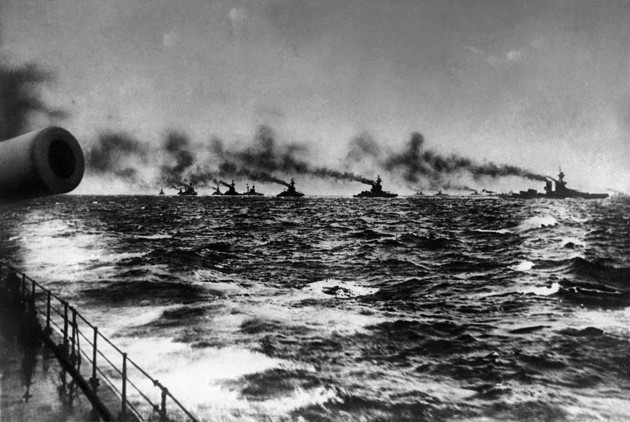 The British Grand Fleet on its way to meet the Imperial German Navy’s fleet for the Battle of Jutland in 1916 (AP)
The British Grand Fleet on its way to meet the Imperial German Navy’s fleet for the Battle of Jutland in 1916 (AP)
Crowe’s answer was unambiguous: Capability was key. As Germany’s economy surpassed Britain’s, Germany would not only develop the strongest army on the continent. It would soon also “build as powerful a navy as she can afford.” In other words, Kissinger writes, “once Germany achieved naval supremacy … this in itself—regardless of German intentions—would be an objective threat to Britain, and incompatible with the existence of the British Empire.”
Three years after reading that memo, Edward VII died. Attendees at his funeral included two “chief mourners”—Edward’s successor, George V, and Germany’s Kaiser Wilhelm—along with Theodore Roosevelt representing the United States. At one point, Roosevelt (an avid student of naval power and leading champion of the buildup of the U.S. Navy) asked Wilhelm whether he would consider a moratorium in the German-British naval arms race. The kaiser replied that Germany was unalterably committed to having a powerful navy. But as he went on to explain, war between Germany and Britain was simply unthinkable, because “I was brought up in England, very largely; I feel myself partly an Englishman. Next to Germany I care more for England than for any other country.” And then with emphasis: “I ADORE ENGLAND!”
However unimaginable conflict seems, however catastrophic the potential consequences for all actors, however deep the cultural empathy among leaders, even blood relatives, and however economically interdependent states may be—none of these factors is sufficient to prevent war, in 1914 or today.
In fact, in 12 of 16 cases over the last 500 years in which there was a rapid shift in the relative power of a rising nation that threatened to displace a ruling state, the result was war. As the table below suggests, the struggle for mastery in Europe and Asia over the past half millennium offers a succession of variations on a common storyline.
Thucydides Case Studies

(For summaries of these 16 cases and the methodology for selecting them, and for a forum to register additions, subtractions, revisions, and disagreements with the cases, please visit the Harvard Belfer Center’s Thucydides Trap Case File. For this first phase of the project, we at the Belfer Center identified “ruling” and “rising” powers by following the judgments of leading historical accounts, resisting the temptation to offer original or idiosyncratic interpretations of events. These histories use “rise” and “rule” according to their conventional definitions, generally emphasizing rapid shifts in relative GDP and military strength. Most of the cases in this initial round of analysis come from post-Westphalian Europe.)
When a rising, revolutionary France challenged Britain’s dominance of the oceans and the balance of power on the European continent, Britain destroyed Napoleon Bonaparte’s fleet in 1805 and later sent troops to the continent to defeat his armies in Spain and at Waterloo. As Otto von Bismarck sought to unify a quarrelsome assortment of rising German states, war with their common adversary, France, proved an effective instrument to mobilize popular support for his mission. After the Meiji Restoration in 1868, a rapidly modernizing Japanese economy and military establishment challenged Chinese and Russian dominance of East Asia, resulting in wars with both from which Japan emerged as the leading power in the region.
The preeminent geostrategic challenge of this era is not violent Islamic extremists or a resurgent Russia. It is the impact of China’s ascendance.
Each case is, of course, unique. Ongoing debate about the causes of the First World War reminds us that each is subject to competing interpretations. The great international historian, Harvard’s Ernest May, taught that when attempting to reason from history, we should be as sensitive to the differences as to the similarities among cases we compare. (Indeed, in his Historical Reasoning 101 class, May would take a sheet of paper, draw a line down the middle of the page, label one column “Similar” and the other “Different,” and fill in the sheet with at least a half dozen of each.) Nonetheless, acknowledging many differences, Thucydides directs us to a powerful commonality.
The preeminent geostrategic challenge of this era is not violent Islamic extremists or a resurgent Russia. It is the impact that China’s ascendance will have on the U.S.-led international order, which has provided unprecedented great-power peace and prosperity for the past 70 years. As Singapore’s late leader, Lee Kuan Yew, observed, “the size of China’s displacement of the world balance is such that the world must find a new balance. It is not possible to pretend that this is just another big player. This is the biggest player in the history of the world.” Everyone knows about the rise of China. Few of us realize its magnitude. Never before in history has a nation risen so far, so fast, on so many dimensions of power. To paraphrase former Czech President Vaclav Havel, all this has happened so rapidly that we have not yet had time to be astonished.
My lecture on this topic at Harvard begins with a quiz that asks students to compare China and the United States in 1980 with their rankings today. The reader is invited to fill in the blanks.
Quiz: Fill in the Blanks
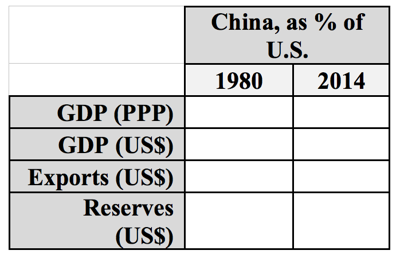
The answers for the first column: In 1980, China had 10 percent of America’s GDP as measured by purchasing power parity; 7 percent of its GDP at current U.S.-dollar exchange rates; and 6 percent of its exports. The foreign currency held by China, meanwhile, was just one-sixth the size of America’s reserves. The answers for the second column: By 2014, those figures were 101 percent of GDP; 60 percent at U.S.-dollar exchange rates; and 106 percent of exports. China’s reserves today are 28 times larger than America’s.
In a single generation, a nation that did not appear on any of the international league tables has vaulted into the top ranks. In 1980, China’s economy was smaller than that of the Netherlands. Last year, the increment of growth in China’s GDP was roughly equal to the entire Dutch economy.
The second question in my quiz asks students: Could China become #1? In what year could China overtake the United States to become, say, the largest economy in the world, or primary engine of global growth, or biggest market for luxury goods?
Could China Become #1?
Manufacturer:
Exporter:
Trading nation:
Saver:
Holder of U.S. debt:
Foreign-direct-investment destination:
Energy consumer:
Oil importer:
Carbon emitter:
Steel producer:
Auto market:
Smartphone market:
E-commerce market:
Luxury-goods market:
Internet user:
Fastest supercomputer:
Holder of foreign reserves:
Source of initial public offerings:
Primary engine of global growth:
Economy:
Most are stunned to learn that on each of these 20 indicators, China has already surpassed the U.S.
Will China be able to sustain economic-growth rates several times those of the United States for another decade and beyond? If and as it does, are its current leaders serious about displacing the U.S. as the predominant power in Asia? Will China follow the path of Japan and Germany, and take its place as a responsible stakeholder in the international order that America has built over the past seven decades? The answer to these questions is obviously that no one knows.
But if anyone’s forecasts are worth heeding, it’s those of Lee Kuan Yew, the world’s premier China watcher and a mentor to Chinese leaders since Deng Xiaoping. Before his death in March, the founder of Singapore put the odds of China continuing to grow at several times U.S. rates for the next decade and beyond as “four chances in five.” On whether China’s leaders are serious about displacing the United States as the top power in Asia in the foreseeable future, Lee answered directly: “Of course. Why not … how could they not aspire to be number one in Asia and in time the world?” And about accepting its place in an international order designed and led by America, he said absolutely not: “China wants to be China and accepted as such—not as an honorary member of the West.”
Americans have a tendency to lecture others about why they should be “more like us.” In urging China to follow the lead of the United States, should we Americans be careful what we wish for?
As the United States emerged as the dominant power in the Western hemisphere in the 1890s, how did it behave? Future President Theodore Roosevelt personified a nation supremely confident that the 100 years ahead would be an American century. Over a decade that began in 1895 with the U.S. secretary of state declaring the United States “sovereign on this continent,” America liberated Cuba; threatened Britain and Germany with war to force them to accept American positions on disputes in Venezuela and Canada; backed an insurrection that split Colombia to create a new state of Panama (which immediately gave the U.S. concessions to build the Panama Canal); and attempted to overthrow the government of Mexico, which was supported by the United Kingdom and financed by London bankers. In the half century that followed, U.S. military forces intervened in “our hemisphere” on more than 30 separate occasions to settle economic or territorial disputes in terms favorable to Americans, or oust leaders they judged unacceptable.
 Theodore Roosevelt with U.S. troops at the Panama Canal Zone in 1906 (Wikimedia)
Theodore Roosevelt with U.S. troops at the Panama Canal Zone in 1906 (Wikimedia)
For example, in 1902, when British and German ships attempted to impose a naval blockade to force Venezuela to pay its debts to them, Roosevelt warnedboth countries that he would “be obliged to interfere by force if necessary” if they did not withdraw their ships. The British and Germans were persuaded to retreat and to resolve their dispute in terms satisfactory to the U.S. at The Hague. The following year, when Colombia refused to lease the Panama Canal Zone to the United States, America sponsored Panamanian secessionists, recognized the new Panamanian government within hours of its declaration of independence, and sent the Marines to defend the new country. Roosevelt defended the U.S. intervention on the grounds that it was “justified in morals and therefore justified in law.” Shortly thereafter, Panama granted the United States rights to the Canal Zone “in perpetuity.”
When Deng Xiaoping initiated China’s fast march to the market in 1978, he announced a policy known as “hide and bide.” What China needed most abroad was stability and access to markets. The Chinese would thus “bide our time and hide our capabilities,” which Chinese military officers sometimes paraphrased as getting strong before getting even.
With the arrival of China’s new paramount leader, Xi Jinping, the era of “hide and bide” is over. Nearly three years into his 10-year term, Xi has stunned colleagues at home and China watchers abroad with the speed at which he has moved and the audacity of his ambitions. Domestically, he has bypassed rule by a seven-man standing committee and instead consolidated power in his own hands; ended flirtations with democratization by reasserting the Communist Party’s monopoly on political power; and attempted to transform China’s engine of growth from an export-focused economy to one driven by domestic consumption. Overseas, he has pursued a more active Chinese foreign policy that is increasingly assertive in advancing the country’s interests.
Never before in history has a nation risen so far, so fast. In 1980, China’s economy was smaller than the Netherlands’. Last year, the increment of growth in China’s GDP was equal to the Dutch economy.
While the Western press is seized by the storyline of “China’s economic slowdown,” few pause to note that China’s lower growth rate remains more than three times that of the United States. Many observers outside China have missed the great divergence between China’s economic performance and that of its competitors over the seven years since the financial crisis of 2008 and Great Recession. That shock caused virtually all other major economies to falter and decline. China never missed a year of growth, sustaining an average growth rate exceeding 8 percent. Indeed, since the financial crisis, nearly 40 percent of all growth in the global economy has occurred in just one country: China. The chart below illustrates China’s growth compared to growth among its peers in the BRICS group of emerging economies, advanced economies, and the world. From a common index of 100 in 2007, the divergence is dramatic.
GDP, 2007 — 2015
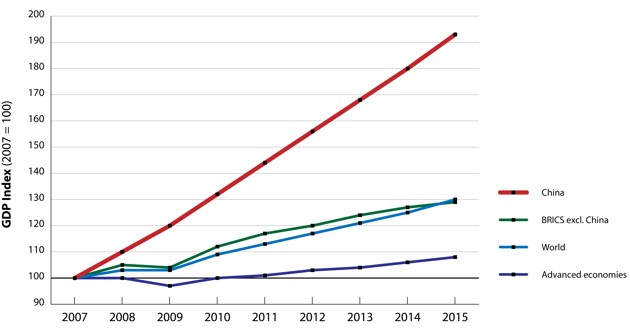 Harvard Belfer Center / IMF World Economic Outlook
Harvard Belfer Center / IMF World Economic Outlook
Today, China has displaced the United States as the world’s largest economy measured in terms of the amount of goods and services a citizen can buy in his own country (purchasing power parity).
What Xi Jinping calls the “China Dream” expresses the deepest aspirations of hundreds of millions of Chinese, who wish to be not only rich but also powerful. At the core of China’s civilizational creed is the belief—or conceit—that China is the center of the universe. In the oft-repeated narrative, a century of Chinese weakness led to exploitation and national humiliation by Western colonialists and Japan. In Beijing’s view, China is now being restored to its rightful place, where its power commands recognition of and respect for China’s core interests.
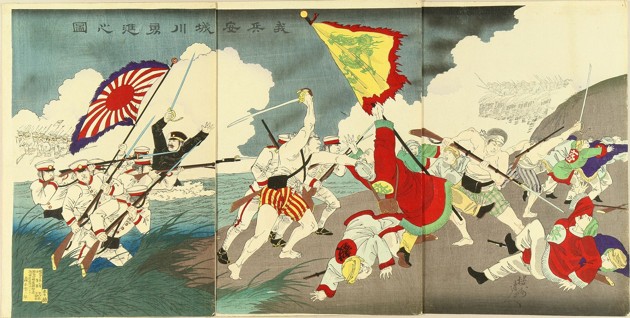 A woodblock painting depicts the First Sino-Japanese War. (Toyohara Chikanobu / Wikimedia)
A woodblock painting depicts the First Sino-Japanese War. (Toyohara Chikanobu / Wikimedia)
Last November, in a seminal meeting of the entire Chinese political and foreign-policy establishment, including the leadership of the People’s Liberation Army, Xi provided a comprehensive overview of his vision of China’s role in the world. The display of self-confidence bordered on hubris. Xi began by offering an essentially Hegelian conception of the major historical trends toward multipolarity (i.e. not U.S. unipolarity) and the transformation of the international system (i.e. not the current U.S.-led system). In his words, a rejuvenated Chinese nation will build a “new type of international relations” through a “protracted” struggle over the nature of the international order. In the end, he assured his audience that “the growing trend toward a multipolar world will not change.”
Given objective trends, realists see an irresistible force approaching an immovable object. They ask which is less likely: China demanding a lesser role in the East and South China Seas than the United States did in the Caribbean or Atlantic in the early 20th century, or the U.S. sharing with China the predominance in the Western Pacific that America has enjoyed since World War II?
And yet in four of the 16 cases that the Belfer Center team analyzed, similar rivalries did not end in war. If leaders in the United States and China let structural factors drive these two great nations to war, they will not be able to hide behind a cloak of inevitability. Those who don’t learn from past successes and failures to find a better way forward will have no one to blame but themselves.
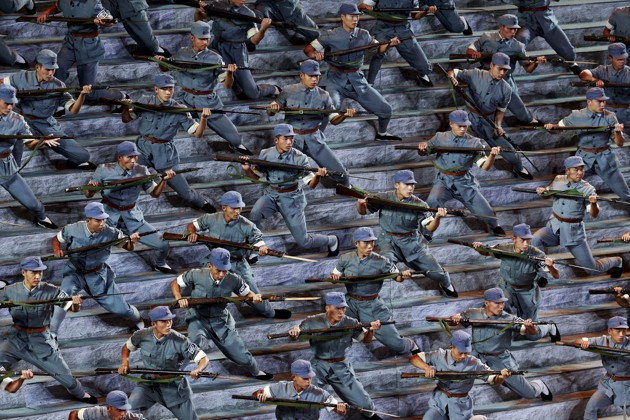 Actors dressed as Red Army soldiers mark the 70th anniversary of the end of World War II, in Beijing. (Kim Kyung-Hoon / Reuters)
Actors dressed as Red Army soldiers mark the 70th anniversary of the end of World War II, in Beijing. (Kim Kyung-Hoon / Reuters)
At this point, the established script for discussion of policy challenges calls for a pivot to a new strategy (or at least slogan), with a short to-do list that promises peaceful and prosperous relations with China. Shoehorning this challenge into that template would demonstrate only one thing: a failure to understand the central point I’m trying to make. What strategists need most at the moment is not a new strategy, but a long pause for reflection. If the tectonic shift caused by China’s rise poses a challenge of genuinely Thucydidean proportions, declarations about “rebalancing,” or revitalizing “engage and hedge,” or presidential hopefuls’ calls for more “muscular” or “robust” variants of the same, amount to little more than aspirin treating cancer. Future historians will compare such assertions to the reveries of British, German, and Russian leaders as they sleepwalked into 1914.
The rise of a 5,000-year-old civilization with 1.3 billion people is not a problem to be fixed. It is a condition—a chronic condition that will have to be managed over a generation. Success will require not just a new slogan, more frequent summits of presidents, and additional meetings of departmental working groups. Managing this relationship without war will demand sustained attention, week by week, at the highest level in both countries. It will entail a depth of mutual understanding not seen since the Henry Kissinger-Zhou Enlai conversations in the 1970s. Most significantly, it will mean more radical changes in attitudes and actions, by leaders and publics alike, than anyone has yet imagined.
No comments:
Post a Comment